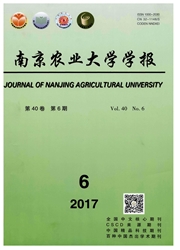

 中文摘要:
中文摘要:
[目的]探讨花后酸雨和渍水胁迫对小麦氮代谢关键酶活性和籽粒蛋白质组成的影响,为小麦抗逆调优栽培提供理论依据。[方法]以小麦品种‘汶农17’和‘扬麦16’为材料,采用盆栽的方式,于开花期进行酸雨和渍水处理,试验设6个处理,以喷施p H5.6酸雨处理为对照,研究了花后酸雨、渍水及其复合胁迫对小麦氮代谢关键酶活性和籽粒中蛋白质及其各组分含量的影响。[结果]与对照相比,花后酸雨、渍水和酸雨渍水复合胁迫均降低了‘汶农17’旗叶中硝酸还原酶、谷氨酰胺合成酶活性和籽粒中谷氨酰胺合成酶、谷丙转氨酶活性,灌浆前期提高了内肽酶活性而灌浆后期降低了此酶活性,最终导致籽粒中蛋白质及其组分含量和谷/醇比显著降低。花后酸雨提高了‘扬麦16’旗叶中硝酸还原酶、谷氨酰胺合成酶和内肽酶活性及籽粒中谷氨酰胺合成酶、谷丙转氨酶活性,显著提高了籽粒中总蛋白含量和醇溶蛋白含量,但是显著降低了其谷/醇比。渍水处理和酸雨渍水复合胁迫均降低了‘扬麦16’旗叶中硝酸还原酶、谷氨酰胺合成酶活性及籽粒中谷氨酰胺合成酶、谷丙转氨酶活性,提高了灌浆前期内肽酶的活性而降低了灌浆后期此酶的活性,籽粒中蛋白质及其组分含量和谷/醇比显著降低。[结论]酸雨对不同小麦品种影响不同,酸雨抑制了‘汶农17’的氮代谢,降低了成熟期籽粒中蛋白质及各组分含量,促进了‘扬麦16’的氮代谢,提高了成熟期籽粒中蛋白质及各组分含量。渍水和酸雨渍水复合胁迫均抑制了小麦氮代谢过程导致最终籽粒中总蛋白含量降低。
 英文摘要:
英文摘要:
[Objectives]The aim of this study was to find out the effects of acid rain and waterlogging on protein composition in grains and key enzyme activities in relation to nitrogen metabolism after anthesis. [Methods]Two winter wheat cultivars( ‘Yangmai16'and‘Wennong 17') were used in a pot experiment to determine the effects of different acidity acid rain( p H2. 5,4. 0 and 5. 6) and waterlogging after anthesis on the activities of N metabolism key enzymes and protein content and components in wheat grains. [Results]Compared with CK,acid rain and waterlogging stress all reduced the activities of nitrate reductase and glutamine synthetase in leaves and the activities of glutamine synthetase,alanine aminotransferase in grains of‘Wennong17'. All treatments increased the activity of endopeptidase at the early grain filling stage but reduced it at the later stage of grain filling and significantly reduced the grain protein and its component contents and glutenin / gliadin ratio. Acid rain increased the activities of nitrate reductase( NR),glutamine synthetase( GS) and endopeptidase( EP) in leaves and the activities of glutamine synthetase( GS) and glutamic pyruvic transaminase( GPT) in grains of‘Yangmai16'. Acid rain significantly increased the grain protein content and gliadin content,but significantly reduced glutenin / gliadin ratio. Waterlogging and double stress of acid rain and waterlogging all reduced the activities of NR and GS in leaves and the activities of GS and GPT in grains of‘Yangmai16'. Waterlogging and double stress of acid rain and waterlogging all increased the activity of EP at the early grain filling stage but reduced it at the later grain filling stage and significantly reduced the grain protein content and glutenin / gliadin ratio. [Conclusions]There were differences in the effects of acid rain on two wheat cultivars. Acid rain suppressed the nitrogen metabolism of‘Wennong17'and reduced the grain protein and its component contents.Acid rain promoted
 同期刊论文项目
同期刊论文项目
 同项目期刊论文
同项目期刊论文
 Genetic Variance in Cadmium Tolerance and Accumulation in Wheat Materials Differing in Ploidy and Ge
Genetic Variance in Cadmium Tolerance and Accumulation in Wheat Materials Differing in Ploidy and Ge Starch granules size distribution in superior and inferior grains of wheat is related to enzyme acti
Starch granules size distribution in superior and inferior grains of wheat is related to enzyme acti Exogenous nitric oxide improves seed germination in wheat against mitochondrial oxidative damage ind
Exogenous nitric oxide improves seed germination in wheat against mitochondrial oxidative damage ind 期刊信息
期刊信息
